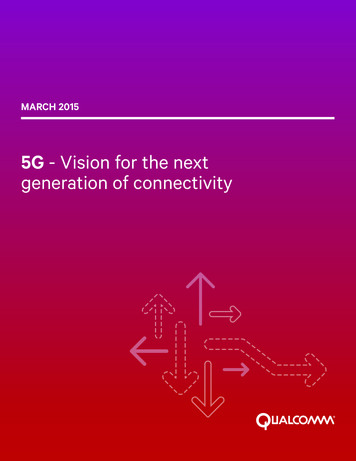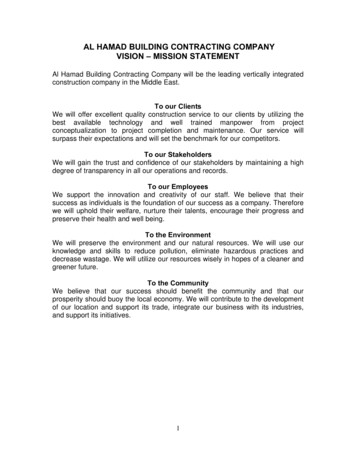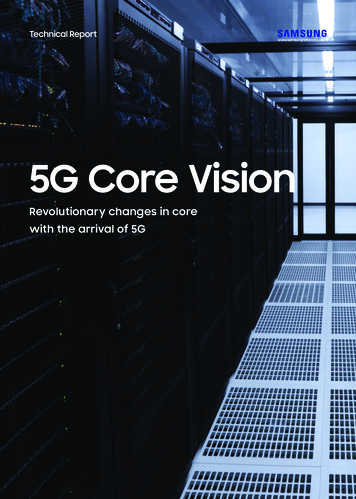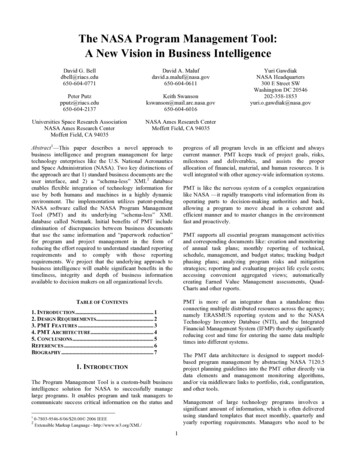
Transcription
MARCH 20155G - Vision for the nextgeneration of connectivity1
DisclaimerQualcomm is a trademark of Qualcomm Incorporated, registered in the United States and other countries. All trademarks ofQualcomm Incorporated are used with permission. Other products and brand names may be trademarks or registered trademarksof their respective owners. This technical data may be subject to U.S. and international export, re-export or transfer (“export”) laws.Diversion contrary to U.S. and international law is strictly prohibited.References in this document to “Qualcomm” may mean Qualcomm Incorporated, Qualcomm Technologies, Inc., and/or othersubsidiaries or business units within the Qualcomm corporate structure, as applicable.Qualcomm Incorporated includes Qualcomm’s licensing business, QTL, and the vast majority of its patent portfolio. QualcommTechnologies, Inc., a wholly-owned subsidiary of Qualcomm Incorporated, operates, along with its subsidiaries, substantially allof Qualcomm’s engineering, research and development functions, and substantially all of its product and services businesses,including its semiconductor business, QCT.Qualcomm Technologies, Inc.5775 Morehouse DriveSan Diego, CA 92121U.S.A. 2015 Qualcomm Technologies, Inc.All Rights Reserved.2
Contents1Executive summary — connecting, enabling, empowering42Not just a new generation, but a new kind of network53Scalability and adaptability across extreme variations of requirements64A user-centric ic network — distributed and virtualizedA unified platform for expanded connectivity needs10105.1 A Unified Air Interface for all spectrum and services5.285.2Leveraging 4G Investments, in parallel to 5Leveraging 4G Investments11126Driving 4G to its full potential, in parallel to 5G137Conclusion153
1Executive summary — connecting, enabling, empoweringGenerational shifts in the world of technology capture the imagination, and promising the opportunity to push the envelope and dothings in entirely new ways. The story of 5G is no different, it will be a transformational force that enables new services, connectsnew industries, and empowers new user experiences for the next decade—and beyond.5G promises to deliver much more than just higher data rates and more capacity. It targets new kinds of ultra-reliable, missioncritical services. Examples include, applications that will allow doctors to remotely control medical procedures or give consumersnew levels of control over their homes or cars, and beyond. 5G aims to effectively connect virtually everything—from simplesensors to complex robots, all while further enhancing traditional mobile broadband service. That means next generation ofapplications, services and use cases will have extreme variation in requirements. To meet this challenge, 5G will require a wholenew user-centric design that can scale and adapt to billions of connected things, provide new ways of connecting everything, andenhance cost and energy efficiency.This user-centric design approach represents a new way of thinking about networks and devices. From a connectivity perspective,users will no longer be mere end-points, they will be integral parts of the network, creating “edgeless” connectivity. But it’s not onlyconnectivity 5G is after, also computing and content need to be distributed closer to the actual user, be it, human, vehicle, machineor “thing” as it is sometimes referred to as.5G is envisioned to be a unified platform for all types of spectrum and bands, from low bands below 1 GHz to emerging higherbands like mmWave, supporting a wide range of new kinds of services, while offering opportunity for new deployment, subscription,charging and business models. A key enabler is a unified air interface design that is scalable and adaptable across all thesespectrum and service types.While 5G continues to be defined, with commercialization anticipated around 2020, 4G continues to evolve in parallel.Enhancements to 4G will bring new capabilities far beyond what is possible today, and steer LTE Advanced in the sametransformational path envisioned for 5G. Multimode devices and simultaneous 5G, 4G, and Wi-Fi connectivity will allow for aseamless and phased 5G introduction. Furthermore, 5G’s single core network is envisioned to support 4G and Wi-Fi access,ensuring that operators’ current and future investments are protected.The mobile industry ecosystem is intently focused on making the 5G vision a reality, and is working together on many fronts toinvent the next generation of mobile experiences.4
2Not just a new generation, but a new kind of networkMobile is already the biggest technology platform in the history. 3G introduced the concept of mobile broadband, and thepopularity of smartphones combined with the advent of 4G resulted in the explosion of ever-increasing mobile data traffic thatwe call the 1000x mobile data challenge. Thanks to the rapid development of mobile computing and the robust LTE Advancedroadmap, the industry is on track to meet the challenge. The 1000x challenge is being addressed by 3G, 4G, and Wi-Fi, and throughthe growing deployment of small cells along with more spectrum.Given that positive prognosis for the future, the question arises, why do we need 5G, and what can it do for us that 4G can’t?The answer is that the vision for 5G is to not only provide better broadband with higher capacity and higher data rates at muchlower cost, but also to address entirely new challenges that span far beyond, to enable new services, empower new types of userexperiences, and connect new industries.Looking beyond today’s trends, 5G aims to connect virtually everything, to go beyond needs of what humans can currentlyperceive, to meet requirements for new classes of services, with new levels of reliability and latency, and to bring new capabilitiesfor control, discovery, and awareness to life. A vision of this magnitude requires not just a new way of thinking but a different kindof a network. 4G LTE initially provided better mobile broadband, but LTE Advanced in many ways is already heading in the sametransformational direction as 5G.5
So, what does this new kind of network entail? Such a network could be defined by three characteristics:SCALABILITY AND ADAPTABILITY5G will have the ability to scale and adapt across an extreme variation of use cases such as uniform, fiber-like broadbandeverywhere (not just higher peak data rates) services; ultra-reliable, mission-critical services such as controlling the powergrid or remote medical procedures (where failure is not an option); and connecting everything from simple sensors to complexrobots, which also means supporting billions of ultra-low energy devices needing expansive coverage, at very-low data ratesand at ultra-low cost.USER CENTRIC DESIGNThe design approach for 5G is rooted in keeping the user at its center. Whether the user is a human, a device, or a “thing,”it will bring content, connectivity, and computing close to the user. For connectivity, users are more than mere end points,they are integral parts of the network (offering “edgeless” connectivity). This distributed approach combined with virtualizednetwork functions will not only reduce latency, but also significantly improve cost and energy efficiency, which are keyobjectives for any new-generation technology.UNIFIED PLATFORM5G will unify access across all types of spectrum and bands, unify all that has been added to 4G, (such as LTE broadcast),and improve upon new, broader dimensions (beyond that of previous generations) to enable a wide range of new kinds ofservices. And the unified platform needs to be scalable for new deployment, business and pricing models as well as be suitedfor realizing new breeds of applications, services and use cases. A key enabler in this is the unified air interface that is scalableand adaptable across all spectrum types and across an extreme variation of services.As evidenced by its defining characteristics, 5G is not just a new generation of technology, but a fundamentally new kind of anetwork needed to address the expanded connectivity needs of the next decade and beyond.3Scalability and adaptability across extreme variations of requirementsThe stated aim of 5G is to enable new kinds of services, connecting new industries, and empowering new user experiences. Theneeds of existing and new use cases are vastly different on many dimensions. Extreme improvements in one dimension generallyrequires a tradeoff in another dimension. In other words, one can’t get ultra-high reliability and ultra-low cost at the same time, so5G has to scale up to right level of performance for one service, but scale down in cost for another service.6
For example, new mission-critical services need highly-reliable links because failure is not an option and down time is absolutelynot permissible. Ultra-low latency is a must because of the immediate nature of action needed. Finally, high security and flawlessmobility are absolute requirements for many of these kinds of services.On the other hand, when you consider the massive number of connected “things” anticipated in the future (e.g., integrated sensorsin many personal, industrial, and enterprise applications), many of those things need to offer ultra-low energy consumption, yearsof battery life, deep coverage to reach very unconventional places, and relatively slow data rates, all at an extremely low cost.At the same time, the next generation of mobile broadband services will have the ability to scale up and aggregate much widerspectrum in order to provide much higher performance and peak data rates, consistently high data rates uniformly across thecoverage area, along with the ability to incorporate other dimensions of improvement. The addition of contextual awareness willenable differentiated services and enhance user experiences, but also allow the networks to be optimized for cost and energyefficiency. Case in point, if the network knows how the connectivity is to be used, e.g., for stationary use cases only, then thenetwork does not need to provision for certain network functions needed for mobility. Having that capability will reduce costsand save energy. The key is that 5G will allow extreme use cases like these to coexist in the same unified 5G design, withoutcompromising the performance of each other.People have an uncanny ability to apply technology in unexpected ways; we are certainly not be able to imagine all theopportunities the ultra reliable, ultra-low latency and secure 5G link will enable in 2020. So apart from addressing extreme varietiesof known use cases, it should also have the ability to scale and adapt to use cases that have yet to be imagined.7
4A user-centric designTo scale for billions of connected things, reduce latency, and improve cost and energy efficiency, 5G needs a holistic approachthat keeps the user at the center. This means, bringing not only connectivity, but computing and content close to the user.Depending on the use case, the user could be a human with a device or wearable, a connected thing such as a sensor, or aconnected vehicle such as a car. Bringing the connectivity, computing and content closer to the user is of paramount importanceto provide instant and immersive visual and audio experiences based on real-time input from on-device cameras and sensors,on-device content (or content cached at the network edge), as well as a way to utilize new ways of discovering and connectingdirectly to relevant things around the user.A good way to understand this usercentric approach is to contrast it witha traditional network-centric or cloudcentric approach (a.k.a. hub and spokearchitecture). In these approaches, thenetwork centrally controls of the systemand orchestrates the connectivity toendpoints, and content flow to andbetween the endpoints, as well as withthe external world.With the user-centric approach,network intelligence and control arealso distributed closer to the users—sometimes referred to as the “edge” ofthe network.4.1User-centric connectivity — where devices are no longer just endpointsIn a world with billions of connected things, 5G will make it possible for the user to connect to relevant things that are nearbyand, in many cases that connection will be made directly, without having to go back and forth through a central network. In 5Gwhere connectivity is user-centric, the user is no longer the endpoint of the network, but rather an integral part of it. New ways ofconnecting will be possible. Devices will connect with one another directly, for both discovery and communication.8
Devices will “multi-hop,” relaying connectivity to things around the user (and the device), as explained below. Device-to-device connectivity seeks out (discovers) relevant information within proximity of the user, and has the abilityto communicate directly with other devices. Already introduced in 4G, the proximal discovery concept will be leveragedand expanded further in 5G. Multi-hop is a mode of connectivity where devices act as hubs and relays for other devices, even forming a mesh network.It will be controlled by operators utilizing their licensed spectrum, as well as by users using unlicensed spectrum. A sampleuse case is in machine-to-machine (m2m) communication where a simple device lacks the power needed to reach macrotowers or small cells. In such a scenario, other devices that are connected to the macros/small cell form a “multi-hop” ormesh network to extend the coverage and connect the unconnected device. Base stations with integrated access and backhaul will be important for further small cell densification, helping solve thechallenges of installing fixed backhaul. Integrated access and backhaul is particularly useful for deployments that usehigher spectrum bands such as mmWave.Lever
For example, new mission-critical services need highly-reliable links because failure is not an option and down time is absolutely not permissible. Ultra-low latency is a must because of the immediate nature of action needed. Finally, high security and flawless mobility are absolute requirements for many of these kinds of services. On the other hand, when you consider the massive number of .











